
Italian company Saipem has secured the $2.75billion contract to lay the first line of the South Stream Offshore Pipeline across the Black Sea from Russia to Bulgaria, with the work starting in June this year.
South Stream will eventually comprise four parallel gas pipelines each 931km long. Its purpose until the Ukraine crisis flared up was to enhance European energy security.
However, the concern now is that South Stream will do nothing of the sort; rather it will increase European dependency on gas from a neighbour it increasingly distrusts, assuming the project doesn’t crash because of the Ukraine crisis.
Assuming that the project is allowed to continue, South Stream will enable Gazprom to hold countries hostage with regard to the cost of gas supplies.
But barely a week after Saipem came out with its good news, the CEO of one of the project’s core partners expressed doubts as to whether South Stream will go ahead.
Paolo Scaroni told an Italian parliamentary hearing in Rome that the future of the pipeline is “somewhat gloomy”.
Scaroni said the Ukraine crisis could threaten the complex permitting process for the pipeline which will bypass Ukraine, running through the Black Sea and a number of European states.
“It will put into question the many authorisations that European countries must give to complete the project,” Scaroni said.
With sanctions looming, it appears that Russian president Vladimir Putin may have shot himself in the foot by annexing Crimea from Ukraine.
Russia has long sought to cut its reliance on pipelines crossing Ukraine, the route for roughly half of its gas exports to Europe, by diverting beneath the Black Sea.
The massive South Stream project, which would be able to supply over 60billion cu.m per year, is seen as crucial for Russia’s ambitions to cement its position as Europe’s dominant gas supplier.
Aside from original project signatories Gazprom and Eni, other shareholders in South Stream are France’s EDF and Germany’s Wintershall.
Turning to the Saipem package, each of the four lines will be made up of over 75,000 individual pipe sections that will be welded together in the firing lines aboard the pipe-laying vessels and then laid at depths to 2,200m
The agreements between pipeline operator South Stream and Saipem cover the design and construction of line-1 and construction of the shallow water parts, shore crossings, landfall and associated facilities for all four pipelines.
Vessels to be employed are the S-layer Castoro Sei, which will deal with shallow to deep sections, and the semi-submersible Saipem 7000 with its J-lay system for ultra-deep water work.
The 7000 has previously laid the Blue Stream pipeline, which also crosses the Black Sea.
For the shore crossings, four micro-tunnels will be constructed on both the Russian and the Bulgarian side, each with a length of more than 1km.
These tunnels will allow construction of the pipeline without significant construction works at the surface of the beach and shallow waters, thereby protecting the integrity of Russian and Bulgarian shores and mitigating environmental impact.
Landfall works start at both ends of South Stream in the summer. Offshore construction will start in the autumn.
According to the schedule, the first pipes will be welded together in batches of four on-board the Castoro Sei to form so-called quad-joints of 48m long in September.
In November, the Castoro Sei will move to Russian waters to start offshore pipe-laying.
At the end of the year, the larger S7000 will take over pipe laying and the Castoro Sei will move back to the Bulgarian sector to continue quad-joint welding.
On board the S7000, the 48m quad-joint pipes will be placed vertically in the vessel’s J-lay tower and welded to the main string before being lowered on to the seabed.
Construction of the first pipeline is scheduled to last until Q3 next year and become operational by the end of that year.
Genesis and outline of South Stream
The hugely ambitious South Stream pipeline project was announced in June 2007 when Paolo Scaroni, the CEO of Italian energy conglomerate Eni, and the vice-chairman of Russian Gazprom Alexander Medvedev signed a memorandum of understanding for the build of South Stream.
This was followed in November 2007 by Gazprom and Eni signing in Moscow an agreement to set up a joint project company for the commissioning of the marketing and technical feasibility study of the project which was and remains seen in some quarters a rival to the projected Nabucco pipeline.
Moreover, doubts were expressed about the feasibility of the South Stream project as it was likely to cost twice as much as Nabucco, which was initially expected to cost about $15-19billion.
It has been claimed too that South Stream is a political project to counter Nabucco and to expand Russian presence in the region. Given events in the Ukraine in recent weeks, such claims appear to have been justified.
South Stream’s offshore section runs from the Russkaya compressor station on the Russian Black Sea coast to the Bulgarian coast.
A 1,455km onshore section would cross Bulgaria, Serbia, Hungary and Slovenia.
The gas pipeline is supposed to end at the Tarvisio gas metering station in Italy. Gas branches from the main pipeline route are scheduled to be constructed to Croatia and to Republika Srpska (the state formation within Bosnia and Herzegovina).
South Stream will be expensive. Only last year, Gazprom indicated that the total cost of the South Stream project – aimed at shipping 63billion cu.m of gas under the Black Sea by 2018 – to $38.4billion. The offshore and European sections of the pipeline are forecast to cost $21.53billion.
Recommended for you
